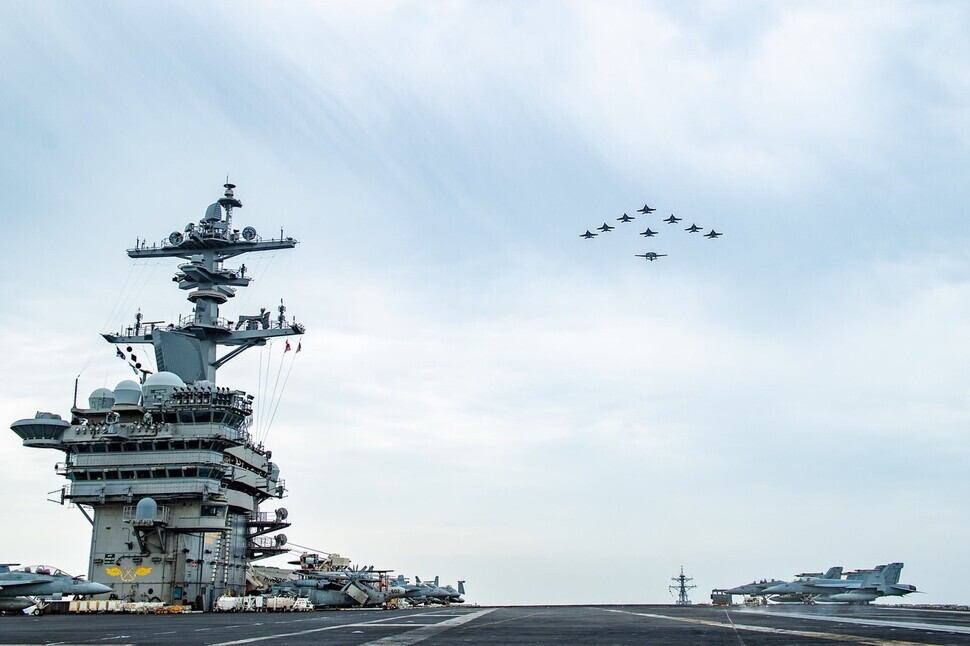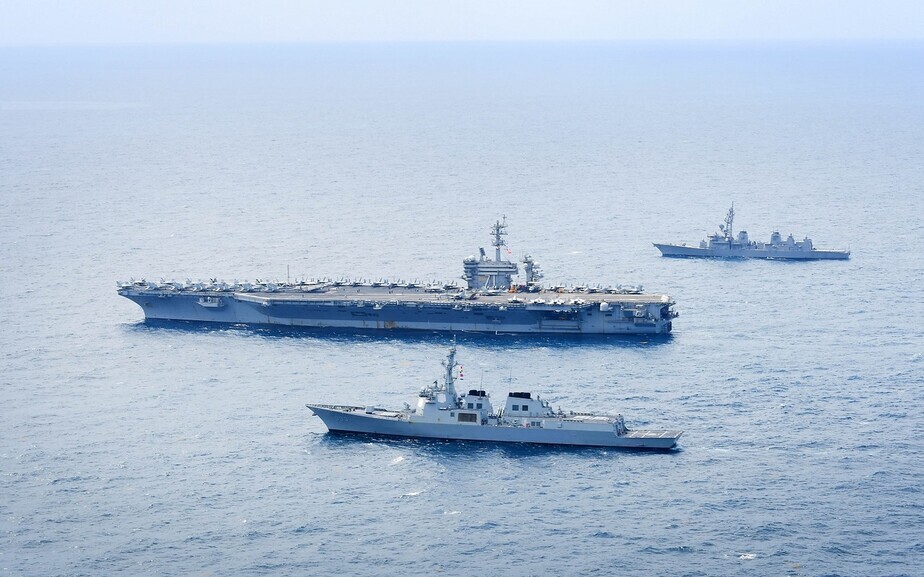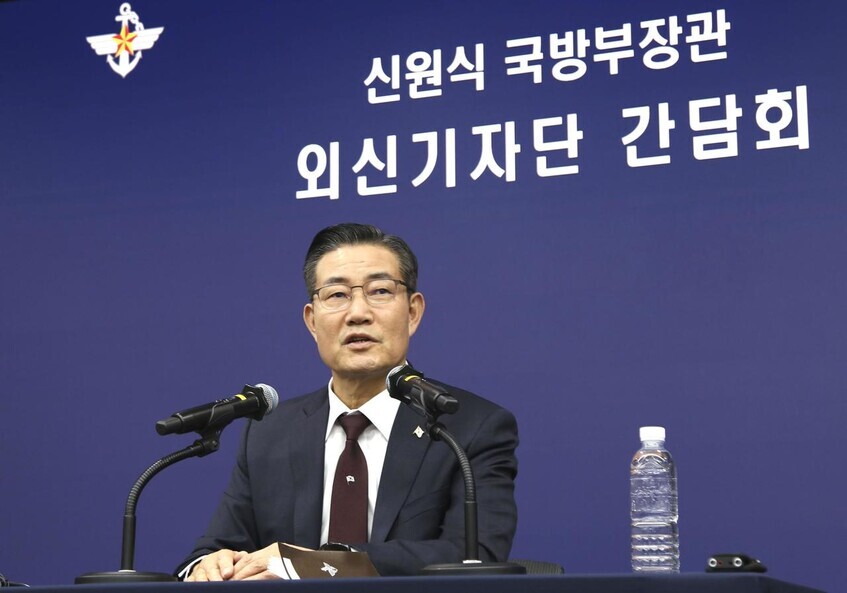hankyoreh
Links to other country sites 다른 나라 사이트 링크
‘We must say no’: Seoul defense chief on Korean, USFK involvement in hypothetical Taiwan crisis

The naval forces of South Korea, the US and Japan carried out a maritime exercise on April 11 and 12. A comparison of the press releases the three sides issued on April 12 shows subtle differences in terms of the objective and location they gave for the drills.
The ROK Navy press release stated the purpose of the exercise was to “boost capabilities for responding to North Korean nuclear and missile threats as well as search and rescue capabilities for vessels in distress.”
Japan’s press release did not mention North Korea. The Japan Maritime Self-Defense Force release said the aim of the drill was to improve the forces’ tactical capabilities and strengthen cooperation with the US Navy and ROK Navy.
The US Navy’s release explained that it “regularly conducts exercises like these to strengthen ties among allied and partner countries.”
The US military’s press release indirectly referred to a response to the North Korea threat by quoting the reaction of Capt. Baek Jun-cheol, commanding officer of the ROK Navy’s Aegis-equipped destroyer Seoae Ryu Seong-ryong, which took part in the exercise.
The three press releases also differed somewhat in their references to the site of the exercise.
The ROK Navy referred to it as “international waters south of Jeju Island,” stressing that the location was near the Korean Peninsula. Japan described the drill site as the “East China Sea.”
The references to international waters south of Jeju and the East China Sea may be seen as the same body of water being referred to by different names. The East China Sea is a part of the western Pacific that extends from south of Jeju Island to Taiwan. It is also the avenue to the Pacific for China’s North Sea Fleet, which is based in Qingdao, Shandong Province, and its East Sea Fleet, which is based in Ningbo, Zhejiang Province.

From the US’ standpoint, the East China Sea is a key strategic location in terms of blocking China’s Pacific expansion.
The US Navy press release said the exercise was “conducted in accordance with international law in international waters.”
When it conducted another trilateral maritime exercise with South Korea and Japan in April 2023, it announced that the site had been the “East China Sea.” Its choice this time to only identify the site as “international waters” may be seen as having been based on the decision not to provoke China more than necessary.
Two weeks ago, more intensive plans for containing China were discussed at a US-Japan summit and US-Japan-Philippines summit in Washington, DC, prompting China to denounce the “smear and attack” against it.
The reason South Korea, the US, and Japan all gave different accounts for the exercise’s site and purpose has to do with differences in their national interests and the threats they face. On the surface, they are united in emphasizing the importance of trilateral security cooperation — but South Korea’s main interest is responding to the North Korean nuclear threat, while the US and Japan’s is pressuring China.
Rising tensions in the Taiwan Strait lead to higher tensions in the East China Sea. From Korea’s standpoint, they are not some fire burning across the sea but a matter closely linked to peace on the peninsula.
For several years, U-2S high-altitude reconnaissance aircraft affiliated with Osan Air Base in Gyeonggi Province have been conducting reconnaissance flights near the Taiwan Strait in the skies over the East China Sea. In effect, a US Forces Korea base is being used for the takeoff of aircraft intended to curb China.
Research institutions in South Korea and overseas have even suggested the possibility of USFK being sent in and the South Korean armed forces becoming involved in a possible emergency situation in Taiwan.
In January 2023, the US-based Center for Strategic and International Studies published a report on a war game simulating a Chinese invasion of Taiwan. It predicted that in such an emergency scenario, two of the four US Air Force fighter aircraft squadrons stationed in South Korea would be sent into Taiwan.
In January of this year, a “Taiwan crisis scenario” was published based on joint research by the Korea Institute for Defense Analyses and the US National Defense University Institute for National Strategic Studies. It laid out the US’ expectations for South Korea under three different scenarios: a Chinese joint strike operation against Taiwan, a maritime blockade operation, and a landing operation.
In the case of a joint strike operation, the US mentioned intelligence sharing, the closing of territorial waters for the Chinese military, and non-military logistical support. In the case of a maritime blockade, it mentioned logistical support in terms of civilian vessels and aircraft transporting US military items, as well as for ships and fighter aircraft sent to perform non-strike operations. In the case of a landing operation, it referred to the redeployment of USFK and loans of components and ammunition by the South Korean military.
A number of research institutions in South Korea and overseas have shared analyses viewing USFK’s deployment in an emergency in the Taiwan Strait as a foregone conclusion and predicting that some involvement by the South Korean military will be unavoidable.
In contrast, South Korean Minister of National Defense Shin Won-sik has drawn attention with remarks rejecting or distancing himself from the possibility of USFK being deployed or the South Korean military becoming involved in the event of an emergency in Taiwan.
Appearing on the KBS program “Sunday Diagnosis” on Sunday, Shin commented on the role of the South Korean armed forces in an emergency scenario in Taiwan.
“If a crisis occurs in Taiwan, the South Korean military’s paramount concern is observing the possibility of North Korean provocations and working with USFK to establish a firm joint defense posture,” he said at the time.

He went on to say, “Since ensuring that there are no further crises not only in South Korea but also on the Korean Peninsula is a value where peace and stability in Northeast Asia, Taiwan and the Indo-Pacific region assume far greater importance, we view firmly upholding the security of the Republic of Korea as a matter of upholding global security, and that is certain where our focus lies.”
This was in response to remarks made in an April 7 interview with one South Korean broadcaster by US Army Pacific commander Gen. Charles Flynn, who expressed hope that the South Korean military would show the power of the alliance in the event of an emergency in Taiwan.
While speaking with foreign correspondents at the Korea Press Center on March 18, Shin was asked about concerns of a security vacuum on the Korean Peninsula if USFK is deployed to address an emergency in the Taiwan Strait.
He replied, “The South Korea-US Mutual Defense Treaty states that USFK will fight if the Republic of Korea suffers external aggression. The US has always been firmly committed to this, and this is the position that South Korea and the US hold with regard to the role of USFK.”
In an interview published on Jan. 22 in the Korea Herald, Shin was asked whether USFK might come to Taiwan’s aid in an emergency.
In his response, he said, “It is inappropriate to ask a question that presumes USFK will be moved out even if there is a clash surrounding Taiwan. By asking such a question, we might send the wrong signal to the US. The question is not a helpful one for our security. USFK has said nothing like that, and it is an excessive hypothetical. We must firmly say ‘No.’”
Shin has faced much criticism for his hard-line stance on North Korea and ideologically biased activities. But when it comes to his stance on Taiwan Strait issues, at least, some could well be left rooting him on to stay resolute.
By Kwon Hyuk-chul, staff reporter
Please direct questions or comments to [english@hani.co.kr]

Editorial・opinion
![[Editorial] Penalties for airing allegations against Korea’s first lady endanger free press [Editorial] Penalties for airing allegations against Korea’s first lady endanger free press](https://flexible.img.hani.co.kr/flexible/normal/500/300/imgdb/original/2024/0502/1817146398095106.jpg) [Editorial] Penalties for airing allegations against Korea’s first lady endanger free press
[Editorial] Penalties for airing allegations against Korea’s first lady endanger free press![[Editorial] Yoon must halt procurement of SM-3 interceptor missiles [Editorial] Yoon must halt procurement of SM-3 interceptor missiles](https://flexible.img.hani.co.kr/flexible/normal/500/300/imgdb/child/2024/0501/17145495551605_1717145495195344.jpg) [Editorial] Yoon must halt procurement of SM-3 interceptor missiles
[Editorial] Yoon must halt procurement of SM-3 interceptor missiles- [Guest essay] Maybe Korea’s rapid population decline is an opportunity, not a crisis
- [Column] Can Yoon steer diplomacy with Russia, China back on track?
- [Column] Season 2 of special prosecutor probe may be coming to Korea soon
- [Column] Park Geun-hye déjà vu in Yoon Suk-yeol
- [Editorial] New weight of N. Korea’s nuclear threats makes dialogue all the more urgent
- [Guest essay] The real reason Korea’s new right wants to dub Rhee a founding father
- [Column] ‘Choson’: Is it time we start referring to N. Korea in its own terms?
- [Editorial] Japan’s rewriting of history with Korea has gone too far
Most viewed articles
- 160% of young Koreans see no need to have kids after marriage
- 2Presidential office warns of veto in response to opposition passing special counsel probe act
- 3Months and months of overdue wages are pushing migrant workers in Korea into debt
- 4[Editorial] Penalties for airing allegations against Korea’s first lady endanger free press
- 5Japan says it’s not pressuring Naver to sell Line, but Korean insiders say otherwise
- 6S. Korea “monitoring developments” after report of secret Chinese police station in Seoul
- 7Hybe-Ador dispute shines light on pervasive issues behind K-pop’s tidy facade
- 8Inside the law for a special counsel probe over a Korean Marine’s death
- 9USFK sprayed defoliant from 1955 to 1995, new testimony suggests
- 101 in 5 unwed Korean women want child-free life, study shows